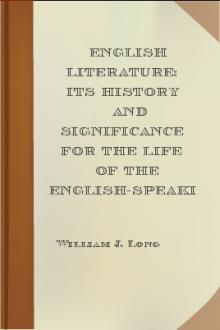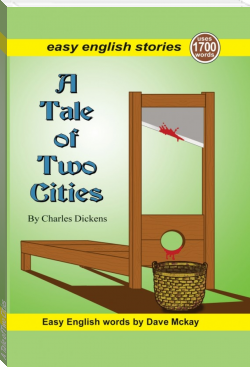English Literature: Its History and Significance for the Life of the English-Speaking World by William J. Long (good books for 8th graders txt) 📕

- Author: William J. Long
- Performer: -
Book online «English Literature: Its History and Significance for the Life of the English-Speaking World by William J. Long (good books for 8th graders txt) 📕». Author William J. Long
WILLIAM MAKEPEACE THACKERAY (1811-1863)
As the two most successful novelists of their day, it is natural for us, as it was for their personal friends and admirers, to compare Dickens and Thackeray with respect to their life and work, and their attitude toward the world in which they lived. Dickens, after a desperately hard struggle in his boyhood, without friends or higher education, comes into manhood cheery, self-confident, energetic, filled with the joy of his work; and in the world, which had at first treated him so harshly, he finds good everywhere, even in the jails and in the slums, simply because he is looking for it. Thackeray, after a boyhood spent in the best of English schools, with money, friends, and comforts of every kind, faces life timidly, distrustfully, and dislikes the literary work which makes him famous. He has a gracious and lovable personality, is kind of heart, and reveres all that is pure and good in life; yet he is almost cynical toward the world which uses him so well, and finds shams, deceptions, vanities everywhere, because he looks for them. One finds what one seeks in this world, but it is perhaps significant that Dickens sought his golden fleece among plain people, and Thackeray in high society. The chief difference between the two novelists, however, is not one of environment but of temperament. Put Thackeray in a workhouse, and he will still find material for another Book of Snobs; put Dickens in society, and he cannot help finding undreamed-of possibilities among bewigged and bepowdered high lords and ladies. For Dickens is romantic and emotional, and interprets the world largely through his imagination; Thackeray is the realist and moralist, who judges solely by observation and reflection. He aims to give us a true picture of the society of his day, and as he finds it pervaded by intrigues and snobbery he proceeds to satirize it and point out its moral evils. In his novels he is influenced by Swift and Fielding, but he is entirely free from the bitterness of the one and the coarseness of the other, and his satire is generally softened by a noble tenderness. Taken together, the novels of Dickens and Thackeray give us a remarkable picture of all classes of English society in the middle of the nineteenth century.
Life. Thackeray was born in 1811, in Calcutta, where his father held a civil position under the Indian government. When the boy was five years old his father died, and the mother returned with her child to England. Presently she married again, and Thackeray was sent to the famous Charterhouse school, of which he has given us a vivid picture in The Newcomes. Such a school would have been a veritable heaven to Dickens, who at this time was tossed about between poverty and ambition; but Thackeray detested it for its rude manners, and occasionally referred to it as the "Slaughterhouse." Writing to his mother he says: "There are three hundred and seventy boys in the school. I wish, there were only three hundred and sixty-nine."
Illustration: WILLIAM MAKEPEACE THACKERAY
WILLIAM MAKEPEACE THACKERAY
In 1829 Thackeray entered Trinity College, Cambridge, but left after less than two years, without taking a degree, and went to Germany and France where he studied with the idea of becoming an artist. When he became of age, in 1832, he came into possession of a comfortable fortune, returned to England, and settled down in the Temple to study law. Soon he began to dislike the profession intensely, and we have in Pendennis a reflection of his mental attitude toward the law and the young men who studied it. He soon lost his fortune, partly by gambling and speculation, partly by unsuccessful attempts at running a newspaper, and at twenty-two began for the first time to earn his own living, as an artist and illustrator. An interesting meeting between Thackeray and Dickens at this time (1836) suggests the relative importance of the two writers. Seymour, who was illustrating the Pickwick Papers, had just died, and Thackeray called upon Dickens with a few drawings and asked to be allowed to continue the illustrations. Dickens was at this time at the beginning of his great popularity. The better literary artist, whose drawings were refused, was almost unknown, and had to work hard for more than ten years before he received recognition. Disappointed by his failure as an illustrator, he began his literary career by writing satires on society for Fraser's Magazine. This was the beginning of his success; but though the Yellowplush Papers, The Great Hoggarty Diamond, Catherine, The Fitz Boodlers, The Book of Snobs, Barry Lyndon, and various other immature works made him known to a few readers of Punch and of Fraser's Magazine, it was not till the publication of Vanity Fair (1847-1848) that he began to be recognized as one of the great novelists of his day. All his earlier works are satires, some upon society, others upon the popular novelists,--Bulwer, Disraeli, and especially Dickens,--with whose sentimental heroes and heroines he had no patience whatever. He had married, meanwhile, in 1836, and for a few years was very happy in his home. Then disease and insanity fastened upon his young wife, and she was placed in an asylum. The whole after life of our novelist was darkened by this loss worse than death. He became a man of the clubs, rather than of his own home, and though his wit and kindness made him the most welcome of clubmen, there was an undercurrent of sadness in all that he wrote. Long afterwards he said that, though his marriage ended in shipwreck, he "would do it over again; for behold Love is the crown and completion of all earthly good."
After the moderate success of Vanity Fair, Thackeray wrote the three novels of his middle life upon which his fame chiefly rests,--Pendennis in 1850, Henry Esmond in 1852, and The Newcomes in 1855. Dickens's great popular success as a lecturer and dramatic reader had led to a general desire on the part of the public to see and to hear literary men, and Thackeray, to increase his income, gave two remarkable courses of lectures, the first being English Humorists of the Eighteenth Century, and the second The Four Georges,--both courses being delivered with gratifying success in England and especially in America. Dickens, as we have seen, was disappointed in America and vented his displeasure in outrageous criticism; but Thackeray, with his usual good breeding, saw only the best side of his generous entertainers, and in both his public and private utterances emphasized the virtues of the new land, whose restless energy seemed to fascinate him. Unlike Dickens, he had no confidence in himself when he faced an audience, and like most literary men he disliked lecturing, and soon gave it up. In 1860 he became editor of the Cornhill Magazine, which prospered in his hands, and with a comfortable income he seemed just ready to do his best work for the world (which has always believed that he was capable of even better things than he ever wrote) when he died suddenly in 1863. His body lies buried in Kensal Green, and only a bust does honor to his memory in Westminster Abbey.
Henry Esmond Works of Thackeray. The beginner will do well to omit the earlier satires of Thackeray, written while he was struggling to earn a living from the magazines, and open Henry Esmond (1852), his most perfect novel, though not the most widely known and read. The fine historical and literary, flavor of this story is one of its most marked characteristics, and only one who knows something of the history and literature of the eighteenth century can appreciate its value. The hero, Colonel Esmond; relates his own story, carrying the reader through the courts and camps of Queen Anne's reign, and giving the most complete and accurate picture of a past age that has ever appeared in a novel. Thackeray is, as we have said, a realist, and he begins his story by adopting the style and manner of a scholarly gentleman of the period he is describing. He has an extraordinary knowledge of eighteenth-century literature, and he reproduces its style in detail, going so far as to insert in his narrative an alleged essay from the Tatler. And so perfectly is it done that it is impossible to say wherein it differs from the style of Addison and Steele.
Realism of EsmondIn his matter also Thackeray is realistic, reflecting not the pride and pomp of war, which are largely delusions, but its brutality and barbarism, which are all too real; painting generals and leaders, not as the newspaper heroes to whom we are accustomed, but as moved by intrigues, petty jealousies, and selfish ambitions; showing us the great Duke of Marlborough not as the military hero, the idol of war-crazed multitudes, but as without personal honor, and governed by despicable avarice. In a word, Thackeray gives us the "back stairs" view of war, which is, as a rule, totally neglected in our histories. When he deals with the literary men of the period, he uses the same frank realism, showing us Steele and Addison and other leaders, not with halos about their heads, as popular authors, but in slippers and dressing gowns, smoking a pipe in their own rooms, or else growing tipsy and hilarious in the taverns,--just as they appeared in daily life. Both in style and in matter, therefore, Esmond deserves to rank as probably the best historical novel in our language.
The Plot of EsmondThe plot of the story is, like most of Thackeray's plots, very slight, but perfectly suited to the novelist's purpose. The plans of his characters fail; their ideals grow dim; there is a general disappearance of youthful ambitions. There is a love story at the center; but the element of romance, which furnishes the light and music and fragrance of love, is inconspicuous. The hero, after ten years of devotion to a young woman, a paragon of beauty, finally marries her mother, and ends with a few pious observations concerning Heaven's mercy and his own happy lot. Such an ending seems disappointing, almost bizarre, in view of the romantic novels to which we are accustomed; but we must remember that Thackeray's purpose was to paint life as he saw it, and that in life men and things often take a different way from that described in romances. As we grow acquainted with Thackeray's characters, we realize that no other ending was possible to his story, and conclude that his plot, like his style, is perhaps as near perfection as a realistic novelist can ever come.
Vanity FairVanity Fair (1847--1848) is the best known of Thackeray's novels. It was his first great work, and was intended to express his own views of the social life about him, and to protest against the overdrawn heroes of popular novels. He takes for his subject that Vanity Fair to which Christian and Faithful were conducted on their way to the Heavenly City, as recorded in Pilgrim's Progress. In this fair there are many different booths, given over to the sale of "all sorts of vanities," and as we go from one to another we come in contact with "juggling, cheats, games, plays, fools, apes, knaves, rogues, and that of every kind." Evidently this is a picture of





Comments (0)